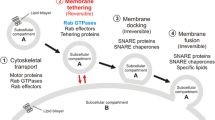Summary
Freeze-fracture replicas of the neuromuscular junction were prepared from untreated retractor unguis muscles of the locust Schistocerca gregaria that were rapidly frozen by contact with a copper block cooled by liquid helium. These replicas were compared with others prepared from tissue following fixation with glutaraldehyde and cryoprotection in glycerol. Freeze-fracture of rapidly frozen tissue produced replicas of high quality with little evidence of tissue damage by ice crystals in the superficial layers. The gross fracturing characteristics of the neuromuscular junction were consistent with replicas from fixed and cryoprotected tissue; all of the membrane specializations were recognisable but with some alterations in infrastructure. In tissue replicas prepared using either method intramembranous particles in the presynaptic membrane were arranged in a bar-like array. The intramembranous particles of this presynaptic bar array of the rapidly frozen material were large and found on the E-face of the cleaved membrane. This contrasts with the P-face distribution of the comparable particles in muscles fixed in glutaraldehyde and cryoprotected in glycerol, in which they are also smaller and more numerous. This difference in partitioning between rapidly frozen, and fixed, cryoprotected nerve terminals is not found at cholinergic synapses and thus may reflect functional differences between the two types of junction.
Indentations of the nerve-terminal membrane occur in replicas from rapidly frozen muscle as well as fixed and cryoprotected muscle suggesting they are not fixation or glycerol-induced artifacts. It is suggested from their position and size that these indentations are more likely to be part of a membrane retrieval system than exocytotic figures.
Similar content being viewed by others
References
Arancia G, Rosati Valente F, Trovalvoci Crateri P (1980) Effects of glutaraldehyde and glycerol on freeze-fractured Escherichia coli. J Microsc 118:161–176
Berthet J, Berthet L, Appelmans F, De Duve C (1951) Tissue fractionation studies. 2. The nature of the linkage between acid phosphatase and mitochondria in rat-liver tissue. Biochem J 50:182
Ceccarelli B, Grohovaz F, Hurlbut WP (1979a) Freeze fracture studies of frog neuromuscular junctions during intense release of neurotransmitter. I. Effects of black widow spider venom and Ca2+ free solutions on the structure of the active zone. J Cell Biol 81:163–177
Ceccarelli B, Grohovaz F, Hurlbut WP (1979b) Freeze fracture studies of frog neuromuscular junctions during intense release of neurotransmitter. II. Effects of electrical stimulation and high potassium. J Cell Biol 81:178–192
Heuser JE, Reese TS (1981) Structural changes after transmitter release at the frog neuromuscular junction. J Cell Biol 88:564–580
Heuser JE, Reese TS, Landis DMD (1974) Functional changes in frog neuromuscular junctions studied with freeze-fracture. J Neurocytol 3:109–131
Heuser JE, Reese TS, Dennis JM, Jan Y, Jan L, Evans L (1979) Synaptic vesicle exocytosis captured by quick freezing and correlated with quantal transmitter release. J Cell Biol 81:275–300
Israel M, Manaranche R, Morel N, Dedieu JC, Gulik-Krzywicki T, Lesbats B (1981) Redistribution of intramembranous particles related to acetylcholine release by cholinergic synaptosomes. J Ultrastruc Res 75:162–178
Lefort-Tran M, Gulik T, Plattner H, Beisson J, Weissner W (1978) Influence of cryofixation procedures on organization and partition of intramembranous particles. Proc 9th Int Cong Electron Microsc, Toronto 2:146
McKinlay RG, Usherwood PNR (1978) The effects of magnesium ions on the fine structure of the insect neuromuscular junction. J Ultrastruc Res 62:83–93
Miller TM, Heuser JE (1984) Endocytosis of synaptic vesicle membrane at the frog neuromuscular junction. J Cell Biol 98:685–698
Newman TM, Duce IR (1983) Membrane specialisations of the neuromuscular junction of the locust, Schistocerca gregaria. Cell Tissue Res 234:691–706
Osborne MP (1975) The ultrastructure of nerve-muscle synapses. In: Usherwood PNR (ed) Insect muscle. Academic Press, London, pp 151–206
Pumplin DW, Reese TS, Llinas R (1981) Are the presynaptic membrane particles the calcium channels? Proc Natl Acad Sci 78:7210–7213
Rash JE (1983) The rapid-freeze technique in neurobiology. TINS June 1983:208–213
Reger JF, Fitzgerald ME (1981) A correlated thin section freeze-fracture study of the neuromuscular junctions of fast acting intersegmental muscle of the chilopodan Lithobius forficatus L. J Submicrosc Cytol 13:1–16
Rheuben MB, Reese TS (1978) Three dimensional structure and membrane specializations of moth excitatory neuromuscular synapse. J Ultrastruc Res 65:95–111
Satir P, Satir B (1974) Partition coefficient of membrane particles in the fusion rosette. Exp Cell Res 89:404–407
Satir P, Satir B (1979) Partitioning of intramembrane particles during the freeze-fracture procedure. In: Rash JE, Hudson CS (eds) Freeze fracture: methods, artifacts and interpretations. Raven Press, New York, pp 43–49
Sleytr UB, Robards AW (1982) Understanding the artefact problem in freeze-fracture replication: a review. J Microsc 126:117–122
Tokunaga A, Sandri C, Akert K (1979) Increase of large intramembranous particles in the pre-synaptic active zone after administration of 4-aminopyridine. Brain Res 174:207–219
Venzin M, Sandri C, Akert K, Wyss UR (1977) Membrane-associated particles of the presynaptic active zone in rat spinal cord. A morphometric analysis. Brain Res 174:207–219
Willison MJH, Brown MR (1979) Pretreatment artifacts in plant cells. In: Rash JE, Hudson CS (eds) Freeze fracture: methods, artifacts and interpretation. Raven Press, New York, pp 51–58
Author information
Authors and Affiliations
Additional information
This work was supported by an S.E.R.C. project grant to I.R.D.
Rights and permissions
About this article
Cite this article
Newman, T.M., Duce, I.R. Preparation-dependent distribution of intramembranous particles in freeze-fracture replicas of the neuromuscular junction of the locust Schistocerca gregaria . Cell Tissue Res. 243, 323–327 (1986). https://doi.org/10.1007/BF00251047
Accepted:
Issue Date:
DOI: https://doi.org/10.1007/BF00251047




